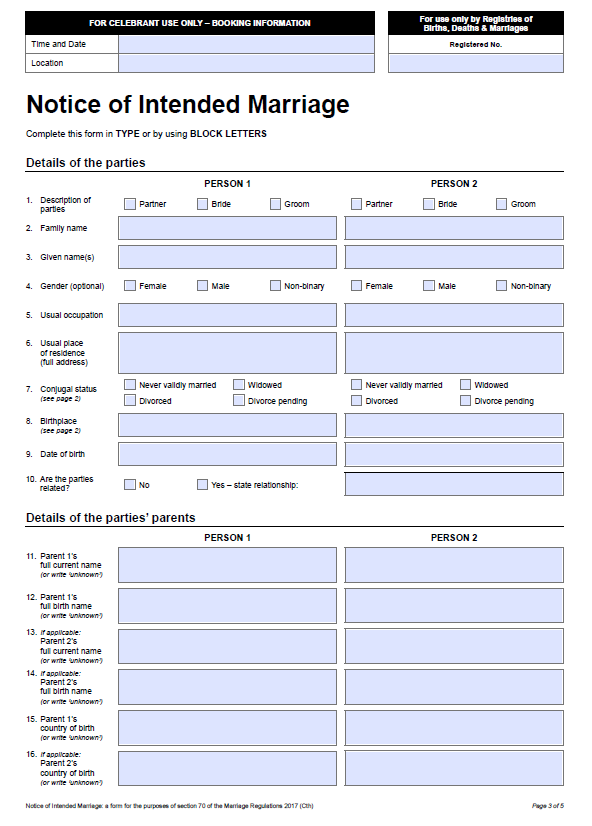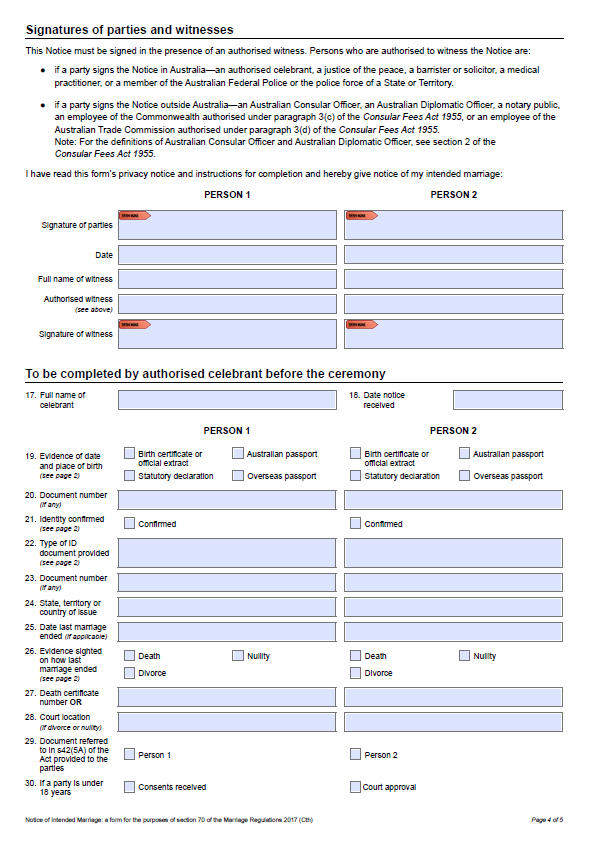New Notice of Intended Marriage Form
From 1st September, 2021 there is a new Notice of Intended Marriage form
From 1 September 2021, all couples and authorised celebrants must use the new Notice of Intended Marriage form (there is also a new Official Certificate of Marriage form and Declaration of No Legal Impediment to Marriage form).
Old Notices of Intended Marriage forms signed and submitted to an authorised celebrant before 1 September 2021 will remain valid for a period of 18 months.
The main changes are listed here:
The main changes in the NOIM are explained below:
The Privacy Notice has been updated. When signing the NOIM, parties will now also confirm that they have read the privacy notice on the front of the NOIM. This aims to ensure that parties have access to information about how their personal information would be used.
Renamed item 4 as ‘Gender’, and provided that the completion of item 4 is optional for marrying couples. The ABS has advised that it can accommodate changes to reporting marriage statistics based on the data provided. The gender option ‘X’ has been renamed ‘Non-binary’ consistent with the Australian Government Guidelines on the Recognition of Sex and Gender.
At item 7, a new option for conjugal status is now included (‘divorce pending’), for use where a party’s divorce has not been finalised at the time the NOIM is lodged. This change will make the NOIM more user-friendly, and remove confusion over whether the NOIM should be updated once a divorce is finalised. Celebrants would still be required to record on the NOIM that they have sighted evidence of the party’s divorce before solemnising the marriage, which would confirm the divorce was finalised prior to the marriage taking place.
Removed old item 10 ‘If a party born outside Australia, total period of residence in Australia’. This information is not required under the Act.
Renamed old items 11 (Father’s name in full) and 12 (Mother’s maiden name in full) as ‘Parent 1’s full current name’ and ‘If applicable: Parent 2’s full current name’, and added new items ‘Parent 1’s full birth name’ and ‘If applicable: Parent 2’s full birth name’. This approach is inclusive of same-sex parents, parents who do not identify as male or female, and parties who only have one legal parent.
Removed old items 15 (Number of previous marriages), 16 (Year of each previous marriage ceremony), 17 (Number of children of the previous marriage or marriages born alive), and 18 (Year of birth of each of those children). This information is not transferred to, or recorded on, the Official Certificate of Marriage. The ABS advised that there are no current statistical requirements regarding the collection of this information.
The questions an authorised celebrant must answer to confirm that they have satisfied themselves about the parties’ identities have changed. The NOIM instructions continue to encourage celebrants to request photographic ID documents to confirm a party’s identity. There are a wide scope of documents that can be used to prove identity (passport, drivers licence, proof of age card, ImmiCard, Keypass identity card). Rather than listing all options, the form allows celebrants to indicate the type of document that was sighted, record the number on the document (if any) and where the document was issued (if applicable).
Additional information is now collected where the NOIM is transferred between celebrants. Feedback from celebrants indicated celebrants would like to record transfer details on the NOIM. The new information collected includes the name of the new celebrant and the date of transfer, as well as an endorsement by the new celebrant that the NOIM was transferred for appropriate reasons.
Details that are worth noting to assist in completing this new Notice of Intended Marriage 2021 form:
One month’s notice: The wedding date must be at least one month from the date the NOIM is lodged. ‘Month’ means a period starting at the start of any day of one of the calendar months; and ending immediately before the start of the corresponding day of the next calendar month, or if there is no such day – at the end of the next calendar month.
Change of venue: There is no problem if the parties change their wedding venue after a NOIM has been completed. This section can be updated to reflect a last-minute change.
Items 1 & 4 – Description & Gender: It is up to each party to decide which option they want to use to describe themselves in the marriage forms, and item 4 (Gender) is optional.
Items 2 & 3 – Names: Each person’s name should be an exact match with their identification documents. For example, a celebrant cannot enter ‘Tess’ for ‘Theresa’ or ‘Bob’ for ‘Robert’ unless they have legally changed their names.
Items 2 & 3 – Names: Each person’s name should be an exact match with their identification documents. For example, a celebrant cannot enter ‘Tess’ for ‘Theresa’ or ‘Bob’ for ‘Robert’ unless they have legally changed their names.
Item 10 – Related parties: Under Australian law, marriages are prohibited between certain parties such as a marriage between persons already married to each other, a person and their grandparent or grandchild, birth or adopted parents and child, or sibling or half-sibling (s23B(1)(b) of the Marriage Act 1961). Related parties who may marry include cousins, an uncle and his niece or nephew, an aunt and her nephew or niece.
Items 11 to 16 – Parties’ parents: It is up to the parties to list their parents using the names as they know them by. Parties do not need to supply evidence of their parents’ names or countries of birth.
Electronic signatures: The Electronic Transactions Act 1999 applies to the Marriage Act 1961. This means that couples, celebrants, and witnesses may complete the NOIM electronically. For further information see the fact sheet on Authorised celebrant obligations in an online environment.
Witnessing signatures: It is possible for one party to sign a NOIM on a different date to the other party and this may involve a different witness. For example, one party may be interstate or overseas in the lead up to the marriage. The authorised witness must sight the signature being completed and then sign and date the NOIM themselves.
Item 18 – Notice received: A celebrant can receive a NOIM once completed and signed by at least one party, when the signature of the other party cannot conveniently be obtained at least one month prior to the proposed ceremony, for example, where one party is overseas, and provided the other party signs the NOIM in the presence of the celebrant before the marriage is solemnised
Item 29 – Happily Ever Before and After: The celebrant should give each party the Happily Ever Before and After brochure as soon as possible after receiving the NOIM.
Any questions, please don’t hesitate to contact me
New Notice of Intended Marriage form page 1


